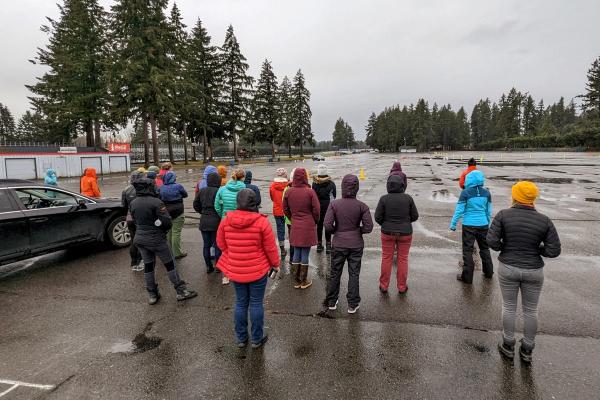Time to Reflect on Mirror Usage

Speed Secrets: Time to Reflect on Mirror Usage
If you can see your own car, you can’t see someone else’s. Every now and then I hop into the driver’s seat of someone’s car and wonder why the side mirrors are adjusted the way they are. I can’t help but ask, “Why do you need to see the side of your own car? Has it ever run into itself?” Way back in the 1980s, there was a paper published by the SAE (Society of Automobile Engineers) that described the method for adjusting side mirrors so that blind spots could be eliminated. I tested it, and then started teaching this approach to every driver I came in contact with, from police recruits to soccer moms, from teens to race drivers. Of all the things I’ve taught, I still have more people thank me for this one.
And yet… there are still many drivers who are not adjusting their mirrors properly, increasing the chances of contact between cars, on and off the track. In the past few months, I’ve gotten behind the wheel of more than one car (that had just been driven on track), and the first thing I had to do was tilt the side mirrors further out to the side.
Yes, modern cars have blind spot monitoring warnings, and yet, if side mirrors were adjusted properly, we wouldn’t really need them. At best, they’d be a good secondary warning to ensure you haven’t missed something. But, if the only way you know that it’s safe to change lanes, or that there’s a car next to you when you’re heading into a corner, is because a warning light tells you, then you’re not an aware driver.
Unless you’re driving a truck or van that does not allow you to see directly behind you, you have three mirrors:
- Rear-view mirror
- Left-side mirror
- Right-side mirror
With that in mind, what do you think the purpose of each is?
- Rear-view mirror: to look directly behind you
- Left-side mirror: to look to the left side
- Right-side mirror: to look to the right side
Notice that the side mirrors are not for looking to the rear. That is what the rearview mirror is for, and there’s no need to duplicate them because when you do, you’re missing what’s to the side of you. Far too many drivers have their side mirrors adjusted so they can also use them as rear-view mirrors. Why?!
Again, if, while sitting behind the wheel of your car, you can see the side of your own car in your side mirrors, you’re likely to miss seeing someone else’s car. What’s most important, seeing your own car or someone else’s?
So how do you adjust your mirrors properly? Practically all modern cars have mirrors that can be adjusted so there are NO blindspots. How?
 Adjust Your Mirrors to Eliminate Your Blindspots
Adjust Your Mirrors to Eliminate Your BlindspotsThe first step is to adjust the rearview mirror to do just that — give you a view directly to the rear. Position it so that it best covers your view straight out the rear window. Don't bother tilting it to one side or the other to assist with your view of traffic to either side of your car. That's what the side mirrors are for.
Next, while sitting in your driving position, adjust the left side mirror so that you CANNOT see the side of your car without tilting your head so that your ear is almost over the outside of your shoulder. If you're like many drivers, this will require angling the mirror out much wider than you've done in the past. Then, adjust the right-side mirror so you CANNOT see the right side of the car until you tilt your head towards the center of the car. Again, this probably means angling it out wider than before.
At first, this is going to seem strange. You probably are used to just seeing the side of your car in those side mirrors. But remember, your car will never run into itself! This applies equally to road or track cars. In fact, build the habit while driving on the street so that it becomes something you no longer think about, and your level of awareness on the track will go up exponentially.
Now that you’ve tilted your mirrors further out to the side, the next step involves checking your view.
While driving down a two-lane road in the right lane, note a vehicle coming up to pass you from behind, in the left lane. Without moving your head, glance in the rearview mirror and follow it as it approaches your car. Just before it disappears from your view in the rearview mirror, glance to the left-side mirror. There it is. Now follow it in the side mirror as it begins to pass you. Then, just before it disappears from the side mirror, you should see it with your peripheral vision. Notice that without even turning your head, you never had a blindspot.
Then try it with the right side. Watch as you pass a vehicle traveling in the right lane go from your peripheral vision to your right-side mirror, to your rearview mirror. Again, no blindspot. If there is, your side mirror adjustment needs some fine-tuning.
If the vehicle disappears for even a fraction of a second, you have a blindspot and should adjust mirrors to compensate. This process should be done every time you get into a car in which the mirrors have not been adjusted by you. It only takes seconds and can make a big difference.
I've tested this method on thousands of different vehicles, and never once have I ended up with a blindspot.
 Right Side Mirror
Right Side MirrorIf you’re driving a car on track that does not have a rearview mirror (or its view is restricted so much that it’s almost as if you don’t have one), think about which is most important: the car directly behind you, or the one just to the side, diving to the inside in a brake zone? Obviously, your view to the sides is most important. When adjusting your mirrors, err on the side of seeing to the sides more than the rear.
When driving on the street, I'm not suggesting you shouldn't shoulder check before changing lanes. You should… kinda, but not really. Do not turn your head and shoulder check to the point where you cannot see the traffic in front of you with your peripheral vision. Think of it as a "shoulder peek" instead of a shoulder check. If you do the traditionally-taught shoulder check (the technique that was developed and taught in Drivers Education in the 1950s!), there will be a fraction of a second (or more) when the blindspot is actually directly in front of your car. That’s not good!
If you do a “shoulder peek,” where you look almost directly into the side mirror (the one that you trust to tell you whether there is another vehicle next to you, now that it’s adjusted properly), your peripheral vision will be peeking over your shoulder while it’s also keeping “an eye” on what’s directly in front of you.
It may take a little while to feel comfortable with not being able to see the side of your own car in the side mirrors (if you really need to see it every now and then, just tilt your head a little). Also, it may take a little time to stop relying on the side mirrors for looking to the rear. It may even take a couple of weeks to get used to the position of the side mirrors. But once you do, I'll guarantee you'll be much more comfortable and confident in traffic. And again, this is why you need to do this with your street car, and make it a habit there so you’re comfortable with it on the track where the consequences of not seeing another car to the side of you are likely to be higher (and you may not be able to rely on the technology of blind spot warning lights).
There are a couple of bonus benefits to setting your mirrors like this. First, it’s easier to see the traffic when merging onto a freeway from an on-ramp; second, bright headlights of vehicles following you at night won't shine directly in your eyes from the side mirrors anymore.
So, please give it an honest try for a while, even if it means gradually adjusting the side mirrors outward more and more each day. I promise you won't go back. You should check your mirrors often enough to always know what is around you at all times — behind and to the sides — no matter how often that is. Some people suggest checking them every 5 to 7 seconds, but it could sometimes be less, sometimes more. On the track, at a minimum, check them each time you enter a straightway after exiting a corner, and give a quick glance prior to the brake zone for corners at the ends of longer straights.
The key is to get used to using the mirrors, so that you don't actually have to turn towards them and look into them. Instead, it is just a quick glance, mostly using your peripheral vision. In fact, if you adjust and use your mirrors properly, you’ll notice most vehicles around you in your peripheral vision — that’s situational awareness.
If you use your mirrors properly, you will always know whether you have an "escape route" on either side to avoid an incident in front of you. If you check them often enough, you will note other vehicles following closely and be able to adjust your driving to suit.
All of this applies to when you’re driving on the street as much, or maybe even more than when you’re on the track. Remember, if you crash on the road because you didn’t see a car in the other lane, and then don’t get to the track, that really sucks! Driving on the street is all about building good habits, and you likely spend more time driving your road car than you do your track car, so if you don’t adjust and use your side mirrors properly on the street, you won’t be able to use them on the track the way you should.




